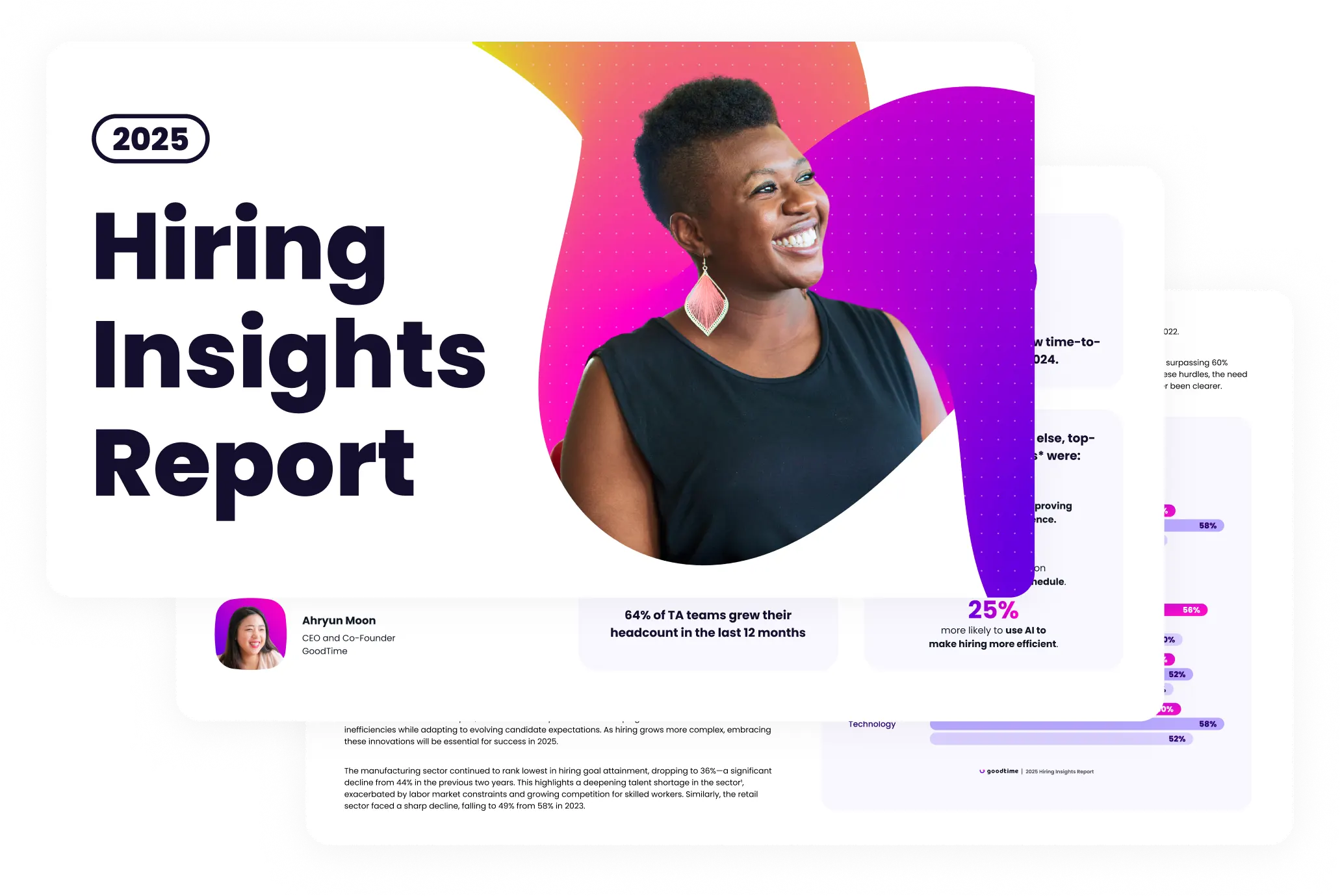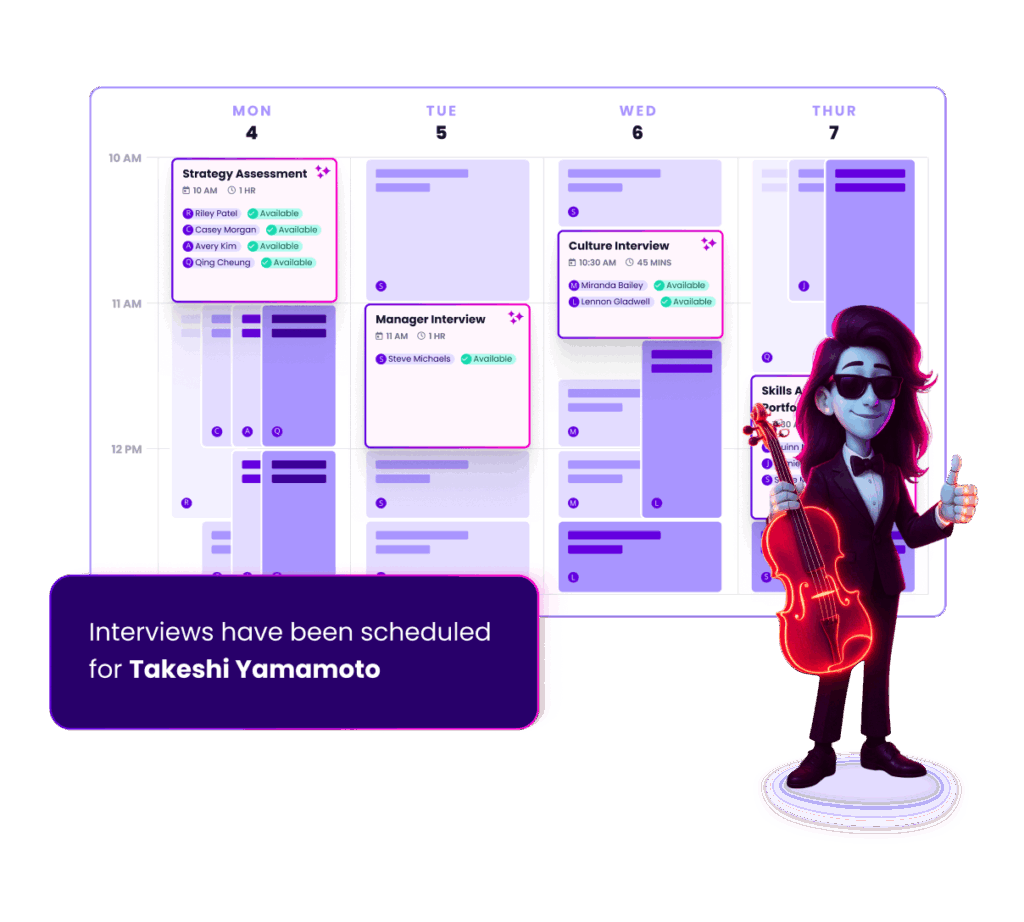From paper-based systems and basic software to AI and the cloud, HR technology has evolved significantly in recent years. It is now critical for automating workflows and improving the employee experience. According to our 2024 Hiring Insights Report, 38% of talent acquisition (TA) leaders said upgrading their hiring tech was a top priority in the previous 12 months. Respondents thought this task was more important than building client relationships, improving overall efficiency, and other hiring processes.
Whether it’s a learning management system, interview scheduling software like GoodTime Hire, or another tool, modern HR wouldn’t be what it is without the latest tech! But what are the benefits of these platforms, and how can you incorporate them into your organization? Find out below, as well as the challenges of implementing HR tech.

Unlock 2025’s top hiring strategies: Insights from 500+ TA leaders
Be the first to uncover deep hiring insights specific to your sector — straight from the highest-performing TA teams.

Key benefits of HR technology
HR technology primarily refers to software and systems that automate various functions in human resources, such as screening resumes, interviewing candidates, and tracking applicants at different recruitment stages.
Improving efficiency
Using HR technologies can make your day-to-day talent operations more efficient. The best software eliminates paperwork, reduces human error, and simplifies workflows, enhancing performance and productivity.
Improving efficiency with HR tools can lead to other benefits, such as reducing operational costs and increasing profitability. Although the best technologies require an outlay, you could generate a return on your investment over time.
Reducing manual tasks
HR technologies automate various manual tasks carried out by your team, including communicating with applicants and identifying their skills and capabilities. By eliminating repetitive jobs, you can save time and dedicate your resources to other things in your business, such as enhancing the candidate experience.
Take GoodTime Hire, for example. This software uses human-centric AI to automate and optimize interview scheduling and management, allowing TA teams to focus on more strategic tasks.
Enhance decision-making
With HR technology, you can make smarter decisions that benefit your organization. Various software tools now include data analytical features, allowing you to generate insights and recruitment metrics. You can view this information on charts, graphs, and other data visualizations, improving visibility into your TA processes.
Optimize the employee experience
HR technology can also improve experiences for your TA team, making it easier for them to recruit and onboard new hires and manage their work. For example, performance management tools allow team members to track tasks and set goals.
Building an effective HR tech stack
Different HR tools serve different functions, so you’ll need to integrate various platforms into your organization for the best results.
Applicant tracking systems
An applicant tracking system (ATS) automates multiple hiring processes, such as collecting resumes and managing applicant profiles. As a result, you can find the most qualified talent for an open position and build stronger teams.
“As businesses continue to emphasize agility and data-driven decision-making, ATS software is set to play an increasingly pivotal role in shaping the future of HR and recruitment,” says Murtaza Faisal Pal, an expert in human resources management.
Examples of ATS systems include Workday, iCIMS, and SuccessFactors.
Payroll software
Payroll is one of the most essential tasks in your organization, and the latest software makes it easier. Tools like QuickBooks and Paychex streamline payroll tasks, such as generating payroll checks and approving employee timesheets. As a result, you can ensure your team gets paid on time and without issue.
Learning management systems
A learning management system (LMS) is essential for employee training and development. Whether you’re using Docebo, TalentLMS, and iSpringLearn, or something else, the right software can manage learning tasks, identify skills gaps in your team, and help employees progress their careers through e-learning programs and other initiatives.
Employee engagement tools
If you want to improve employee engagement, these platforms can help. The latest software makes it more convenient for team members to communicate, track their progress, and, essentially, do their jobs!
Employee engagement tools fall into various categories. For example, communication tools like Slack and Microsoft Teams allow team members to exchange real-time information, while project management platforms like Asana and Monday.com track workplace activities and tasks.
Whatever tools you choose, you’ll want ones that scale and grow with your organization. Cloud-based systems are advantageous if your TA team is remote, allowing employees to collaborate from different locations.
Emerging trends in HR technologies
AI, recruiting analytics, and other developments have improved the functionality of software and systems. Let’s take a look at some of the hottest trends in HR tech right now.
AI and machine learning
Artificial intelligence and machine learning can improve HR in various ways, such as reducing workloads for team members and enhancing candidate sourcing. This technology automates resume screening, interview scheduling, and other time-consuming tasks, improving workflows. According to our 2024 Hiring Insights Report, 42% of TA leaders want to utilize AI over the next 12 months to make hiring more efficient.
Human-centric AI tools enhance candidate and employee experiences while maintaining the human touch. For example, GoodTime Hire doesn’t seek to replace your TA team but to strengthen it by offering features that grow your business, such as personalized bulk texting, high-volume interview scheduling, and workflow automation.
Data analytics
Data analytics processes large volumes of data, resulting in valuable insights about your business. You can predict future HR challenges, identify cost-cutting measures, and collect other information that informs decision-making in your organization. According to a study conducted by EY, 93% of companies plan to continue increasing their data and analytics investments.
Automation
Automation tools streamline all the TA tasks your team might not have the time or resources for, including benefits management.
“In the realm of employee benefits administration, the ultimate goal is to achieve a system that is both highly efficient and user-friendly,” says people strategist Steve Taylor. “The integration of technology offers a clear path to simplifying and enhancing this crucial aspect of workplace management.”
By automating core TA processes, you can also free up time and minimize human error.
Mobile HR tools
Mobile technologies allow employees and job candidates to carry out functions on a smartphone or tablet. For example, texting software lets you communicate with applicants via SMS or WhatsApp.
Technologies for remote and hybrid teams
The latest HR software supports remote and hybrid workforces by allowing employees to communicate and collaborate when away from the office. According to the Pew Research Center, around a third of workers with jobs they can do remotely are working from home all the time — up from 7% before the COVID-19 pandemic.
Challenges of implementing HR technology
Adding new HR technologies to your business may lead to several problems:
- Integration issues: The newest HR software might not be compatible with your existing tools, resulting in challenges such as data loss and delayed workflows. Ensure a new product integrates well with your current technology before investing in it.
- Poor user adoption: Technologies with a steep learning curve can be complex for your team, leading to poor adoption rates. Investing in proper training whenever adding a new tool to your stack can overcome this challenge.
- Security risks: Moving information from existing systems to new tools can increase the risk of data loss and theft, so always develop an effective migration strategy. You’ll also want to work with secure HR tech vendors that take data security seriously. HR teams can be extremely vulnerable to cybersecurity risks, including phishing and ransomware.
HR tech FAQs
HR technology includes tools and software that automate, streamline, and enhance various HR processes like recruiting, employee management, and benefits administration.
Human-centric AI tools, like GoodTime, enhance candidate and employee experiences without replacing the human touch, automating tasks like interview scheduling and personalized communications.
Data analytics processes large amounts of data to provide insights that inform decision-making, predict challenges, and identify cost-saving opportunities.
Automation reduces manual tasks and minimizes human error, allowing HR teams to focus on higher-value work, like employee engagement and strategic planning.
Mobile HR tools let employees and candidates manage tasks via smartphones or tablets, such as communicating through SMS or completing applications on the go.
It enables seamless communication and collaboration for remote teams, ensuring employees stay connected regardless of location.
Common challenges include integration issues with existing systems, poor user adoption due to complexity, and increased security risks during data migration.
The future of HR technology
HR technology can improve efficiency, reduce manual tasks, and provide other benefits for employees and job candidates. Whatever tools you choose, HR technology will likely continue to support TA teams and leaders in the future, with new products emphasizing adaptability and continuous improvement.
Right now, one of the most exciting innovations is human-centric artificial intelligence, which everyone at GoodTime Hire passionately believes in. Unlike conventional AI, this technology augments human capabilities rather than replaces them, benefiting your employees.
Want to learn more about GoodTime’s human-centric AI tools? Discover how our software automates interview management, enhances high-volume scheduling, improves workflows, and allows team members to communicate with candidates via SMS and WhatsApp. We create technological solutions for HR professionals in various industries, including manufacturing, healthcare, retail, and financial services.
Additional resources to continue learning:
- Human-centric AI is the Future of Hiring
- 6 Recruitment Marketing Strategies to Attract Talent
- Optimizing Your Interview Process for Better Hires
- Mastering Full Cycle Recruiting: A Comprehensive Guide
Upgrade your hiring journey with AI
GoodTime’s AI agents orchestrate the entire hiring journey — screening, scheduling, messaging, and more — so talent teams hire faster with a better candidate experience.





